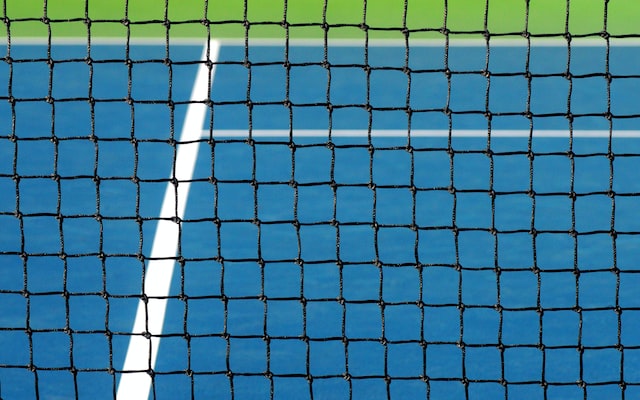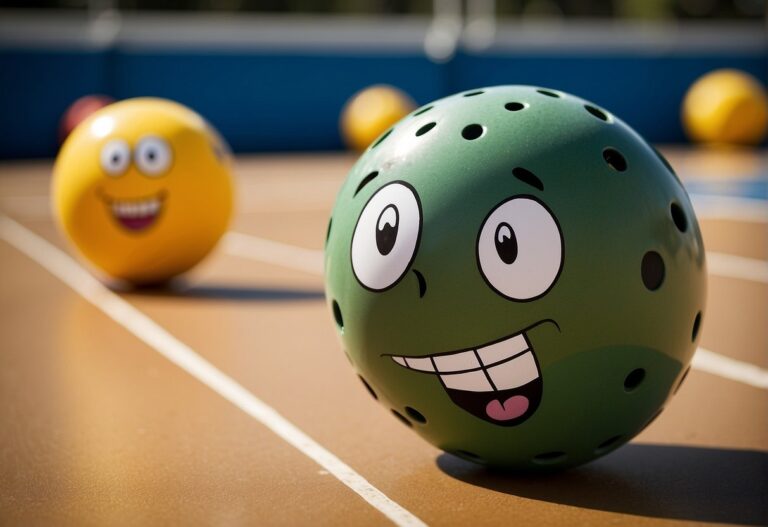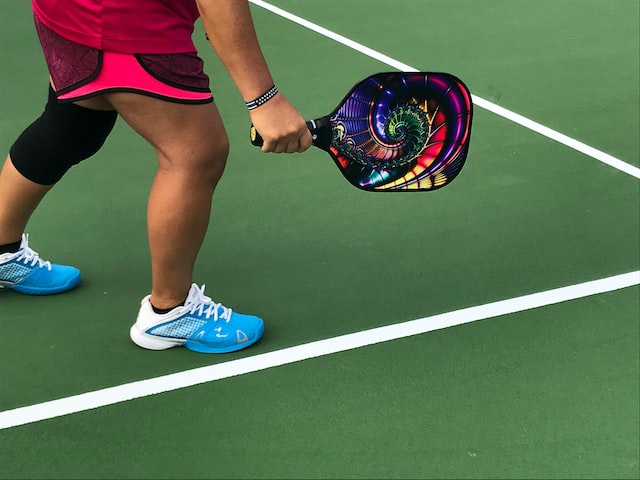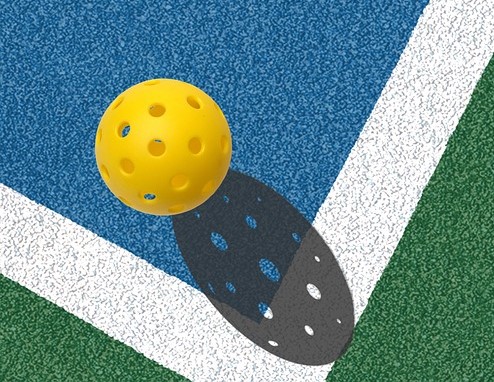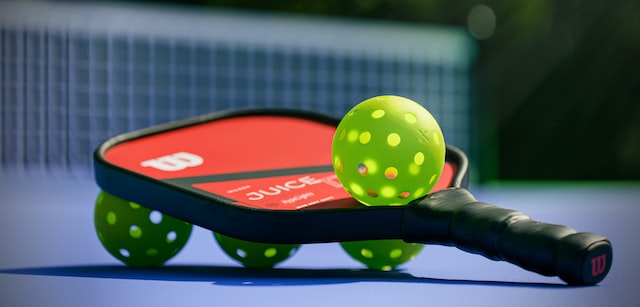Pickleball Rules And Regulations: Understanding The Game
There are some affiliate links below, but they are all products I highly recommend. For more info, view my disclosure here.
Have you heard of the game pickleball? It’s a fun and exciting sport that’s becoming increasingly popular. If you’re looking to try your hand at this unique game, it’s important to understand the rules and regulations. This article will explain what you need to know about pickleball so you can get out there and start playing!
Pickleball is an intriguing combination of tennis, badminton, and table tennis. It’s easy to learn and can be played both indoors and outdoors. The court size depends on the age of the players – younger children play on a smaller court while adults usually play on a larger one. Pickleball also uses a net that is hung lower than those used in tennis or badminton, making it easier for beginners to hit the ball over it.
The rules are surprisingly simple – two or four players use paddles to hit a plastic ball back and forth over the net without letting it touch the ground. Points are scored when an opponent fails to return the ball or hits it out of bounds. Games can last anywhere from 15 minutes for a quick match up to 45 minutes for more serious playtime. Now that you have a good idea of how pickleball works, let’s dive into understanding its rules and regulations so you can join in on all the fun!
What Is Pickleball?
What is Pickleball? Pickleball is a popular sport that combines elements of tennis, badminton and table tennis. It’s played on a court that’s the same size as a doubles badminton court, with a net slightly lower than a tennis net. The game is played with a paddle and plastic ball, similar to the one used in table tennis. The rules are relatively simple and can be adapted to fit different age groups and skill levels.
To begin the game, two or four players stand opposite each other on either side of the net. Players must hit the ball over the net to their opponent’s side without it touching the ground or going out of bounds. The point is won when your opponent doesn’t return your shot or returns it out of bounds. The first team to 11 points wins the game if there are two players; if there are four players, the first team to 15 points wins.
The rules of pickleball may vary depending on who you’re playing with but some basic aspects remain consistent – like keeping score, serving correctly, returning shots and winning points by keeping your opponent off balance. These simple rules make pickleball an enjoyable game for all ages and experience levels so grab a paddle and get playing!
Equipment Requirements
To play pickleball, you will need some specific equipment. The most important pieces of equipment are the paddle, the ball and the net. Other than that, all you need is an open space to play.
The paddle used for pickleball is made from a variety of materials including aluminum, graphite and composite materials such as fiberglass or carbon fiber. It should be no longer than 17 inches in length and no wider than 8 inches. Paddles come in different weights and colors to suit individual players’ preferences.
The pickleball ball can be made of plastic or rubber and must weigh between 0.8 ounces to 1.1 ounces with a diameter of 2.9 inches. The type of ball used depends on the surface you are playing on – outdoor courts use plastic balls while indoor courts require rubber balls for better control and bounce characteristics.
Pickleball nets are typically 20 feet long with a height of 36 inches in the middle and 34 inches at each end post. Nets can be made from nylon or polyester mesh or from steel cable covered in nylon mesh material for greater stability. Nets also come in different colors to match your individual style!
Court And Net Specifications
Pickleball is typically played on a court 20 feet wide and 44 feet long. The court features two parallel lines that are 7 feet from the net and designate the non-volley zones. The center of the court is marked by a short service line, which is used to demarcate the area in which players can serve. The net is made of polyethylene mesh and supported by a metal frame that stands 34 inches at each end and 36 inches in the middle. It’s important for recreational players to note that no matter what surface they play on, all pickleball courts must meet these same standards.
At each end of the court there should also be boundary lines that measure 20 feet long and define the outer limits of play. Official pickleball games are usually played with a perforated plastic ball that weighs between 0.8 ounces and 1.2 ounces and has an outside diameter of 2.9 inches to 3.3 inches; however, some players prefer lightweight foam balls or even wiffle balls due to their slower speed and spin capabilities.
In order for any game of pickleball to be fair and legal, it’s essential that all courts adhere to these specifications so that players have equal opportunity to compete according to standard rules. With everyone on the same page regarding court size, boundaries, net height, type of ball used, etc., then everyone can enjoy playing this fast-paced sport without worrying about one side having an advantage over another due to discrepancies in equipment or setup
The Serve
The serve is the initial stroke in a game of pickleball. Players must use an underhand motion to hit the ball over the net and into the opposing court. The ball must be served diagonally, alternating between the right and left service courts with each serve. When serving, a player must keep both feet behind the baseline and may not step on or over it until after making contact with the ball. A fault occurs if any part of the body touches the court before contact is made with the ball.
Players have two chances to get their serve in play. If they fail to do so on both attempts, they lose their serve to their opponent. A fault that occurs while attempting to return a serve also results in loss of serve. The server must wait for their opponents to be ready before starting their serve, otherwise a foot fault will occur and they’ll lose their turn at serving again.
When returning a serve, players may let it bounce or attempt to volley it back across the net. It’s important to note that volleying is only allowed after a successful return of service; if someone volleys during service, it’s considered a fault resulting in loss of point or change of server depending on whose fault it was.
Scoring System
Pickleball is a fun and easy game to learn and play. The scoring system is relatively simple, but it’s important to understand how it works. In pickleball, the first team to score 11 points is the winner unless both teams have 10 points, in which case the game must continue until one team has a two-point advantage. Every time a team scores a point, they switch sides of the court.
Points can be scored when the ball lands on the other team’s side of the court or when their opponents make an error. If an error is made, the point goes to whichever team did not make the mistake. When serving, if the ball touches any part of the service box lines then that counts as an ace and that team earns a point. It’s also important to note that only one serve attempt is allowed per side for each rally and if it doesn’t land in bounds, then no point will be awarded for either team.
When playing pickleball it is essential to know how each point is scored so everyone can keep track of who’s winning! This may seem like a lot of rules but they are all designed to make sure that everyone has a fair and enjoyable game!
Doubles Vs Singles Play
When playing pickleball, there are two main ways to play: in doubles or singles. In doubles, each team consists of two players and a net is placed across the center of the court. The court will be divided into two halves, with each team occupying one side. In singles, each player occupies their own side of the court and plays against one other player.
In doubles pickleball, the players must stay on their respective sides of the court at all times during play. The server must serve diagonally over the net to the other side’s service box. During play, a player may not enter their opponent’s side of the court until after they make contact with the ball. When returning shots that go over the net, players can move from one side to another as long as they remain within their designated area on each side.
In singles pickleball, players may move around freely as long as they remain inside their designated half-court area. The same rules apply for serving and returning shots: when serving or returning a shot, it must be hit diagonally over the net to your opponent’s service box. Pickleball is a game that requires strategy and skill no matter which way you choose to play – singles or doubles!
Strategies For Success
Now that we have discussed the differences between doubles and singles play, let us turn our attention to some strategies for success in pickleball. The most important tip is to always be aware of the opposing team’s position. This means watching their footwork and movement, as well as any patterns they may be using. Being able to anticipate where the ball will go can help you get ahead of your opponents.
The best way to stay one step ahead is by developing a good understanding of the rules and regulations of pickleball. By learning when you can hit the ball over the net and under what circumstances, you can better plan your shots to give yourself an advantage. Additionally, take note of when your opponent hits a shot that goes out of bounds or into the net so you can capitalize on it.
Practice makes perfect! Spend time getting comfortable with how different shots feel when you hit them, such as volleys, smashes, lobs and dinks. This will also help you develop muscle memory so that you don’t have to think about where each shot goes every time. Playing regularly with more experienced players is also a great way to improve your game and refine your skills. All these tips will help ensure that you are playing at your highest level possible in pickleball matches.
Staying In Bounds
Staying in bounds is essential for a successful pickleball game. To remain in play, players must keep their feet within the court boundaries. The official court size is 20 feet by 44 feet and if a player steps out of those dimensions, they are considered “out”. If a player hits the ball out of the court, it counts as a fault and the serve changes to the other team. The boundary lines are also an extension of the net and any shots that land on them are considered in-play.
The service box is an important aspect of staying in bounds during pickleball. It’s located behind both baselines and extends two feet beyond each sideline. Players must stay within this box when serving and cannot step across it until after their shot has been hit. If they do step outside of it before their shot, then it’s considered a fault and the point goes to their opponents.
Players need to be aware of their positioning throughout pickleball games. Staying within the court boundaries allows them to take advantage of all angles available to hit winning shots as well as avoid making mistakes that would result in faults or losing points for their team. By understanding these rules, players can ensure that they remain in bounds and put themselves in prime position for success during pickleball matches.
Official Rules & Regulations
With the basics of staying in bounds established, it’s time to move on to official rules and regulations. Pickleball is governed by the USA Pickleball Association (USAPA), which sets the standards for all pickleball tournaments and league play. The USAPA rules are based on those used by the International Federation of Pickleball (IFP). These two governing bodies set the official regulations for pickleball equipment, court size and dimensions, scoring, penalties, and more.
The USAPA publishes an updated version of their rulebook each year to keep up with changes in the sport. The rulebook provides an in-depth look at all aspects of the game, from picking a court surface to maintaining a tournament draw sheet. There are also sections dedicated to coaching guidelines, refereeing policies, and safety protocols. It is important for players and coaches alike to become familiar with these rules so that they can ensure fair play during games.
Players should also understand court etiquette when playing pickleball. This includes being respectful of other players on the court by not disturbing them or making unnecessary noise or distractions. Additionally, proper sportsmanship should be maintained throughout a match – this includes shaking hands after each game regardless of who won or lost. Following these simple rules will ensure that everyone has a safe and enjoyable pickleball experience.
Etiquette And Sportsmanship
Good etiquette and sportsmanship is essential for a successful pickleball game. Players should show respect for their opponents and the game itself. It’s important to be aware of the player’s actions and words at all times. Here are some things to keep in mind while playing pickleball:
First, it’s important to be courteous and polite. Avoid making negative comments about opponents or the game, as this will only create hostility during play. Instead, focus on demonstrating good sportsmanship by encouraging others and congratulating them on their successes. It’s also important to be mindful of other players’ safety and avoid any aggressive behavior such as pushing, shoving or damaging equipment.
Second, always adhere to the rules of the game. If a disagreement occurs between players, it should be discussed calmly and respectfully with a referee or team captain present if needed. Additionally, players should never tamper with the scores or try to influence the outcome of the match through foul play or cheating in any way.
Lastly, when exiting the court after a match is finished, shake hands with your opponents as a gesture of respect regardless of who won or lost. This is an essential part of showing good sportsmanship and sets a tone for future games that can foster positive relationships between competitors.
